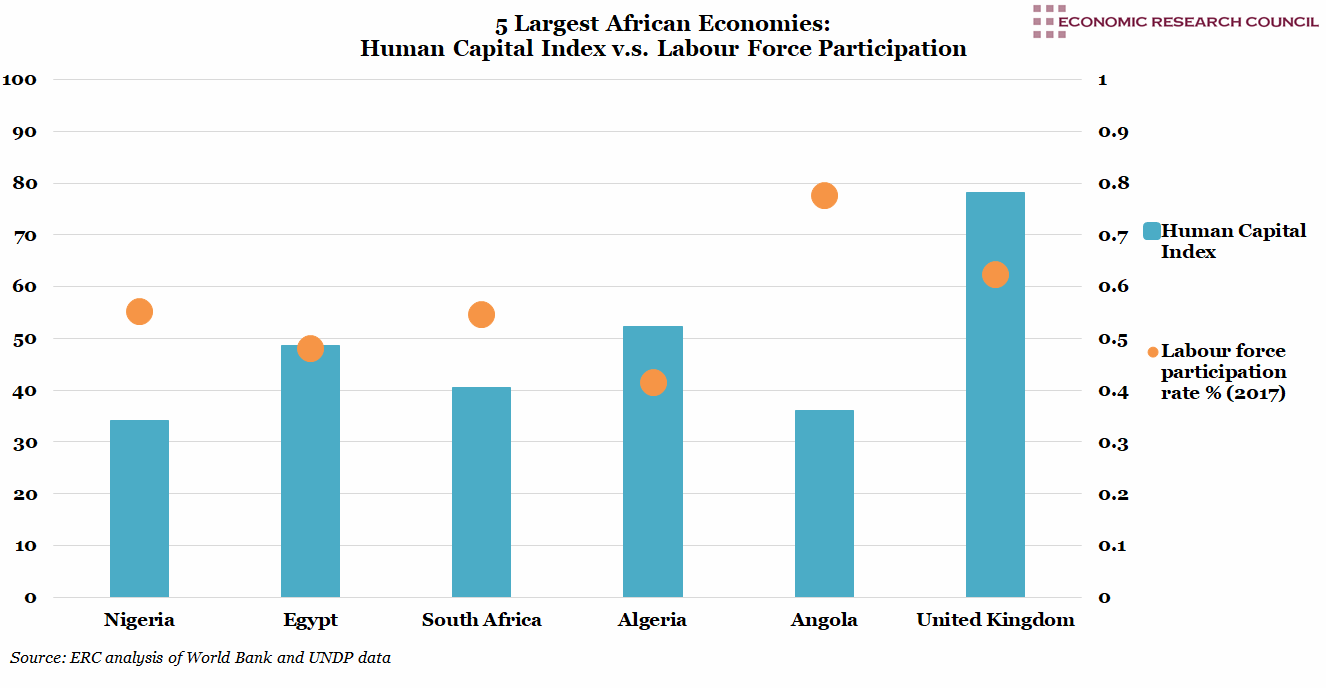Summary
The HCI is a newly-published measure from the World Bank. It is a gauge of the future contribution that any child born today can be expected to make to the economy, subject to the health and educational conditions within their country. HCI reflects the anticipated productivity of a child born today on a scale of zero to one. It aggregates data from six indicators: three relating to population health and three to education quality.
According to the World Bank, the chart shows the remarkable scope for improvement that exists in nations where full health and complete education are yet to be realised. Despite being the largest economy in Africa, Nigeria’s Human Capital Index (HCI) of 0.342 is the lowest of the five largest economies in the continent. With a labour force participation rate a quarter lower than Nigeria’s, Algeria has the highest HCI of all its African peers at 0.523. However, the highest HCI score in Africa still lags behind the UK by 0.258. Egypt’s economy has overtaken South Africa’s as the second largest on the continent, yet its labour force participation rate is less than 1 in 2. The HCI suggests that South Africa can expect children born today to fulfill only 40.6% of their potential in terms of human capital. Comparatively, Angola has the highest labour force participation rate (77.6%, around one fifth higher than the UK’s), but its HCI indicates that, although employed, its citizens are still facing barriers in maximizing their economic potential.
What does the chart show?
The chart displays the human capital index (HCI) of the five largest economies in Africa, alongside the UK for reference. This is shown by the blue bars and measured against the right-hand axis. Each country’s total labour force participation (those aged 15 and over) is displayed as a percentage by the orange circular marker and measured against the left-hand axis. The data originates from the UNDP and refers to 2017. The five African nations are listed by GDP from highest to lowest, with the UK last for context.
The HCI score given is relative to ideal conditions of full health and complete education, to which, theoretically, a score of one would be awarded. For global context, the leading nation in terms of HCI is Singapore which achieves a score of 0.884, indicating that there remains room for improvement.
Why is the chart interesting?
The World Bank aims its newest metric to encourage countries to recognise the economic importance of health and education system investment. The World Bank posits this as instrumental in the achievement of greater equity and long-term economic growth. In the year since the project was first publicised, the World Bank reports that demand for loans towards education and health investment have increased by 70%, although whether this rise is attributable to the publication of this index is in no way proven. The report states that a staggering 56% of children born today will lose over half of their potential lifetime earnings due to government failure to invest effectively in the health, education and commensurate future productivity of workforces. It is suggested that cumulatively over 50 years, a HCI under 0.5 would lead to an annual loss of 1.4% in GDP growth.
It is important to note that the chart shows five nations which were colonised for many centuries combined. Colonial rule often involved the dominance of agriculture and/or the extraction of raw materials from African nations, which has had a profound and lasting impact on the structure of formerly colonised countries’ economies.
Readers are invited to explore the global data for themselves here. By way of an introduction, some interesting facts about each nation shown on the chart are below:
Nigeria:
Although the government provide nine years’ free education, there remain 10.5 million children not engaged in schools. This disproportionately leaves certain groups underserved (for example those in rural areas or in poverty, the disabled or travelling/nomadic people). Using contact tracing in the 2014 Ebola outbreak, Nigeria was the first country to effectively contain and eliminate the disease that was ravaging other West African states.
Egypt:
Since 1960, there has been dramatic increase to life expectancy, from 48.1 years to 71.5 in 2016. Although nine years’ education is compulsory for Egyptian children, there has been a mushrooming industry of private tuition, where only those who are wealthy enough to pay for private teaching services are able to receive schooling adequate for skilled work.
South Africa:
The HIV prevalence rate (ages 15-49) is 18.9%, which erodes the life expectancy and welfare of around 5.3 million people and is the fourth highest in the world. Bloomberg ranked South Africa as the second ‘most stressed out’ country in the world, as 53% of South Africans in the workforce cannot or do not take any annual leave.
Algeria:
In Algeria, a comprehensive national health service has offered free hospital treatment, medication and outpatient care to all citizens since 1975. The state’s second largest public expenditure is on education, accounting for 15% of its national budget. In principle, thirteen years of schooling is free to Algerian students, with ten years compulsory. Of the nations on the chart, Algeria has the lowest labour force participation rate of 41.4%. This figure is depressed by the lowest female labour participation of the countries shown: only 16.7% of the female population are in employment.
Angola:
Angola’s labour force participation rate for working-age women was 76.3% in 2017, the highest among its peers and 6% higher than the UK’s. Angola is followed by South Africa, where 52.2% of women are in the workforce. By law, education is compulsory and free for eight years. However, many students are not in school due to lack of infrastructure and educators, so Angola’s average learning-adjusted years of schooling is the lowest of the countries examined, at only 4.1 years.
If you’d like to learn more about the data please click here.
Week 42, 2018


